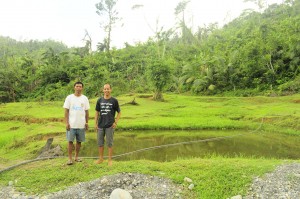It’s the end of another day. As the twilight sky turns a deep blue color and the cold breeze starts to drift from the mountains of Oriental Mindoro, darkness has completely covered the lands except for the only light coming from a fire burning in the middle of a big wooden house.
Around the fire, clusters of people of all ages are talking, laughing, or singing by the warmth of the flames, their shadows flickering on the wooden walls of the balaylakoy.
This is how Vicente Sara, the Barangay Sub-Project Management Committee Chairperson of Barangay Caburo of Naujan, Oriental Mindoro remember the days when the Alangan culture flourished.
In the heart of Alangan culture
The Alangan tribe is one of the eight Mangyan tribes of the island of Mindoro each with a completely distinctive culture and language. In the earlier days, the Mangyan Alangans were known to live in these great houses where up to 20 families, usually of the same ancestry, share one living space. The word balaylakoy literally translates to “malaking bahay” or “big house”, the word balay meaning “house” and lakoy meaning “big”.
The traditional balaylakoy provides more than a home and protection for the Alangans. It is also a sacred place where rituals and gatherings are conducted.
Each year, during harvest season, the Alangans have a celebration called the pamago. Each family residing in the balaylakoy contributes some of their harvest and together they pound rice to remove the husk in the palangganan, the center of the balaylakoy. Residents, visitors from other balaylakoys, even outsiders are welcome to feast on their harvests.
“Pinakamasayang panahon sa balaylakoy ang pamago (The pamago is the happiest time in the balaylakoy)”, Vicente Sara, more fondly called “Ka Beting”, cheerfully recounts.
This much awaited festivity is the Alangans’ thanksgiving for the bountiful harvest and their way of praying for the promise of the continuous richness of their lands. And it is just one of the ceremonies and rituals that are led by their greatly respected elder and healer known as the aplaki.
Aside from rituals, the Alangans also gather around the fire that usually burns continuously every day in the palangganan, to resolve conflicts, plan for activities of their community and more importantly to bond with their family.
Through sharing stories and just enjoying each other’s company through ambahans which can be chanting rhymes similar to poetry or alternately singing songs, the Alangans preserved their culture and lived in harmony.
And because the Alangans lived together, almost all of the adults are able to work on their kaingin or farm and all the children can be left with a guardian.
“Lahat ng aspeto ng buhay ng katutubong Mangyan ay naka angkla sa balaylakoy kaya ganun na lang ang pagpapahalaga sa balaylakoy (All aspects of the lives of the Mangyans is anchored on the balaylakoy, which is why we give it much importance),” explains Ka Beting.
Decline of tradition
However, due to the vast amount external influences, many of the Mangyan Alangans today have started to settle in individual houses and actual balaylakoys have grown more uncommon in communities.
“Ilang pamayanan na lang ng katutubong Alangan ang may ganitong balaylakoy (Very few Alangan tribes still have a balaylakoy), Ka Beting declared.”
According to Domingo Torres, the Barangay Captain of Caburo, it has been almost 15 years when their last balaylakoy was destroyed by a typhoon.
Along with the custom of living under one roof, the Alangans’ sense of unity and togetherness seemed to fade. “Talamak na ang pagkakanya-kanya (Selfishness is becoming prevalent)”, says Ka beting.
With all the changes in their system, it has become challenging for the aplaki and other community leaders to detect problems within the village. When a family is faced with difficulties, it has become a common mindset for others to ignore what doesn’t concern them. Thus, conflicts have also become more difficult to resolve.
“Samantala, kapag nasa isang balaylakoy, hindi nila kayang sabihin na ‘bahala na yan’, nandoon pa rin yung pananagutan, yung problema nila, problema ko rin,(however, when in a balaylakoy, they can’t just say ‘come what may’, they are also liable for others’ problems, their problems are my problems too)”, said Ka Beting.
And because the balaylakoy is strongly connected to the Mangyan Alangan culture, their traditions and customs are slowly being forgotten along with its disappearance, especially by the youth.
“Nalulungkot din kami na nakikita na ang aming kultura ay unti unting naglalaho na kaya gustong gusto naming ibalik ito (We are saddened by seeing our culture slowly disappear, which is why we want to bring it back), Ka Beting said with determination.
For many of the older members of the community, though they no longer live in the balaylakoy, the place has remained a sacred place where traditions and rituals that are spared by the effects of outside influence are still practiced.
“Kung hindi man tuluyang maibalik ang kultura namin dati ay unti unting makita sana ng susunod na salinlahi kung gaano kahalaga at gaano kadaming gamit ang balaylakoy (We may not be able to totally revive our culture but we want the next generations to know the importance of the balaylakoy and its many uses)”, explained Ka Beting.
Preserving a culture of unity
Through the Kapit-Bisig Laban sa Kahirapan Comprehensive and Integrated Delivery of Social Services (KALAHI-CIDSS), one of the core poverty alleviation programs of the Department of Social Welfare and Development (DSWD), the community of Brgy. Caburo was granted more than two hundred thousand pesos for the construction of their balaylakoy.
Ang mga activity na ginagawa sa balaylakoy ay hindi pang personal na interes and purpose kundi pang komunidad (Activities conducted in the balaylakoy are not for personal interest and purposes but for the community), says Ka Beting.
Remembering the earlier days when they had a balaylakoy, Wilma Garon, one of the older community members, shared that trainings on handicrafts and livelihood were done in the balaylakoys.
The construction of the balaylakoy has an essential role in their fight to preserve their culture. As Ka Beting explained, while sharing stories and chewing betel nut around the fire in the palangganan, the aplaki also teaches the beliefs and values of the Alangans to the youth.
The whole community supports the project knowing that the balaylakoy may be the key to save a culture nearing its extinction. “Nakikita ko sa pamayanan naming mangyan na naghahari na ang impluwensya na galing sa labas (I can see in our Mangyan community that external influence is becoming dominant)”, Ka Beting declared.
Nevertheless, together with the community, Ka Beting has remained resolute to achieve their goal of protecting their own culture even through the challenges they faced in preparing for the implementation of the project.
The community encountered problems in land acquisition since the land of Barangay Caburo used to be owned by priests and was endorsed to about 30 families who now held the land title.
They first asked for an agreement with the priests but the documents proved to be unnecessary because they needed the consent of the families. Though it took some time, through the community’s combined efforts, all the families who now owned the land gave their permission for the construction of the balaylakoy.
According to Ka Beting, the core purpose of the balaylakoy is to ensure that the spirit of unity lives within the community. And to successfully build their balaylakoy, they will have to strengthen this characteristic and work in harmony.
Accordingly, the whole community has expressed their willingness help in the construction through bayanihan.
Modernized balaylakoy
The traditional balaylakoy is a wooden house with an undivided interior containing the palangganan in the middle. The planned balaylakoy in Barangay Caburo however, will have concrete pillars, indigenous materials such as wood and bamboo for the walls and floors, and will have two extra rooms and a comfort room.
This modernized balaylakoy was designed for the benefit of the whole community.
Barangay Caburo is composed of three sitios with the other two situated further up the mountains. Aside from rituals that are usually performed in the balaylakoy, they will also have a meeting place for large gatherings and assemblies which can also serve as their temporary shelter.
The balaylakoy can also accommodate students from neighboring and distant barangays who attend school in Barangay Caburo especially during rainy days when there are floods or when rivers become dangerous to cross as the water level rises.
Once completed, part of the balaylakoy will also serve as the office of the Sanguniang Barangay. Important documents may be housed safely inside and barangay officials will be available whenever community members have concerns and complaints.
They planned to build a structure that can be used for all the different activities for the community, for the tribe or for the barangay. Nevertheless, with all its uses, the balaylakoy is still ultimately intended to be more than just a multi-purpose hall.
“Buhay na buhay ang kultura sa balaylakoy (The culture is alive within the balaylakoy)”, says Ka Beting, and the community hopes that with its construction, the rest of the Alangans will be encouraged to protect and preserve their beliefs. Their goal through the balaylakoy, which is the center of the Alangans’ way of life, is that the youth and future generations will appreciate and be proud that they are part of a rich and beautiful culture.
Though Barangay Caburo is one of the farthest and most depressed areas in the Municipality of Naujan, the dedicated volunteers of KALAHI-CIDSS persevered in processing the approval of their sub-project and have committed to continue to work hard for the implementation later this year.
Domingo Torres and Vicente Sara stands in front of the land where the balaylakoy will be contructed.
![]()



